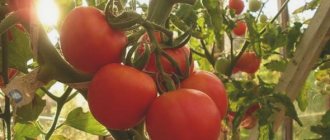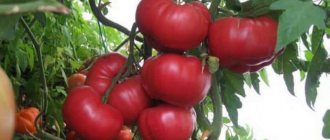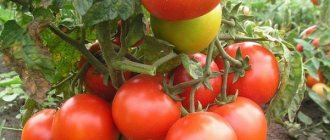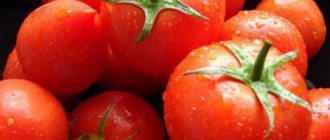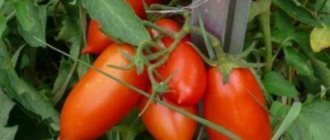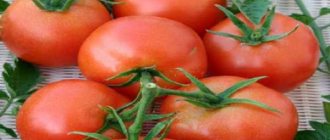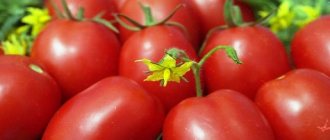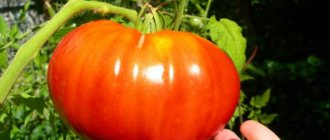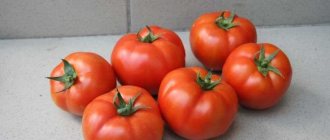| Ripening period: | average |
| Shape, weight of fruits: | heart-shaped, with standardization up to 1-1.5 kg, without – 200-500 g |
| Bush type: | determinant |
| Growing regions: | All |
| Productivity: | 5 kg per bush |
Tomato Pudovik or Sevruga is a large-fruited mid-season variety of Siberian selection, recognized as one of the best. Under the first name, it was adopted by the State Register in 2007, the creators were O.V. Postnikova and V.N. Dederko. It is recommended for planting in all zones of Russia, but it works better in regions with harsh climates, where it ripens even in open ground. In the south, Pudovik is too hot, the tomato requires increased attention, so it is usually not replanted there.
Description and characteristics of the variety
The Sevruga tomato is mid-season, determinate, in greenhouses it grows up to 1.5-1.7 m. In open ground, the dimensions are more modest - from 1.2 to 1.5 m. When planted in the south, the bush can barely reach 100 cm.
Pudovik tomatoes form rather weak shoots, this is noted by everyone who planted the variety. The fruit load is large; without a garter, the bush will fall to the ground or break.
Sevruga leaves have a regular shape, thin, and there are a moderate number of stepsons.
The first flowering raceme is formed after 6-7 leaves. Subsequent ones - after 2-3 internodes. Pedicels without articulations. The flowers are large.
Fruit characteristics
Sevruga tomatoes look like a heart with a slightly elongated nose (see photo). The color is reddish-crimson; often yellow spots remain on the sides hidden from the sun when fully ripe. The surface is slightly ribbed.
Tomato Sevruga is a typical beef. The pulp is fine-grained, with a high content of dry matter. In cross section it resembles fresh meat.
The Sevruga tomato variety produces few seeds, which makes it difficult to collect your own planting material.
The taste of tomatoes is very good, sweet, the sourness is barely noticeable. Pudovik is suitable for all types of processing, except for whole-fruit canning. But it is better to use these tomatoes for fresh consumption.
It should be taken into account that the juice from Sevruga will be thick and sweet, and will be enjoyed by children and adults. But it is not very suitable for preparing first courses.
Features of fruiting
The tomato variety Pudovik ripens in medium terms and forms large fruits even without rationing. The largest grow on the lower hands - up to 500 g. As they move upward, they become smaller and smaller, but rarely weigh less than 150 g.
The Sevruga tomato cannot boast of straightened fruits. Each cluster contains very large and relatively small tomatoes.
If the ovaries are normalized, leaving 2-3 pieces in each bunch, half-kilogram tomatoes will not be a rare exception, but an average size. Record holders of 1-1.5 kg can be grown by topping the bush and removing all but the best fruits. Then Sevruga will direct its forces to the formation and ripening of the remaining tomatoes.
Productivity
Pudovik bears fruit well in greenhouses and open ground. From one bush, a tomato yields up to 5 kg. If it is grown in 2 trunks, per 1 sq. m you can plant 3 bushes. The total weight of the fruits will not change, only their number will increase and the weight of each will decrease.
When formed into 1 shoot per 1 sq. m have 4 tomatoes. The yield will be 15 or 20 kg, respectively.
Use
The fruits have a fleshy texture and a slightly sour taste. The dry matter level is average. The number of seeds and chambers is small. Tomato is very good for long-term storage. They are used fresh and also processed, so the variety is universal. In both cases the taste will remain just as great.
What can you cook from this tomato?
- various juices;
- salads;
- sauces;
- gravies;
- various preparations.
Planting and care
The characteristics indicate that Pudovik is suitable for all regions, but it is better to plant the variety in cool climates.
In the south, it may not correspond to the description, although it bears fruit and requires increased attention. So it makes no sense to grow it there. Moreover, there are many other good-yielding tomato varieties for warm regions.
Sowing seeds
Seeds for seedlings are sown 55-60 days before planting. Tomatoes are placed in beds when the ground warms up to 15° C. In greenhouses - up to 10° C. The exact time depends on the region and weather forecasts.
You can focus on the following timing for sowing Pudovik tomatoes for seedlings:
| Regions | Greenhouses | Open ground |
| Middle lane | beginning – mid March | mid-March – early April |
| North-West, Siberia, Ural | second half of March | beginning – mid-April |
Features of care
In the Middle Zone and Siberia, the Sevruga tomato has proven itself, according to reviews, to be a fairly stable and not too demanding variety. It needs to be fed regularly so that the fruits become full and do not become smaller.
It is necessary to ensure that phosphorus-potassium fertilizers predominate in Pudovik’s “diet”. Nitrogen is definitely needed (it is the building material for the plant), but in very limited quantities. Otherwise, the tomato will increase its green mass to the detriment of fruiting and will become vulnerable to pests and pathogens.
The care package must include preventive treatments. The Pudovik tomato is quite demanding when it comes to watering. But it is impossible to over-moisten the soil - this leads to cracking of tomatoes, rot, and provokes the development of other diseases.
Bush formation
The Sevruga tomato variety requires pinching and tying to a support from an early age. The lower leaves are removed only when the ovary above them begins to fill. Pudovik can be grown in 1 or 2 trunks.
To obtain large tomatoes, pinch the brushes. To grow truly gigantic fruits weighing 1-1.5 kg, you will only have to leave a few ovaries on the bush.
History of origin
Historically, the tomato, which will be discussed further, is often called Pudovik.
They have identical characteristics, but there is a difference. For example, the first difference is that the Pudovik variety appeared before Sevruga. The first one was entered into the State Register of Russia back in 2007. There is no mention of the second grade in the State Register at all. In this regard, many disputes arose and the most meticulous gardeners conducted hundreds of experiments to prove the similarity of all characteristics. They grew seeds labeled “Sevryuga” and “Pudovik” in neighboring beds, under the same conditions, and long ago came to the general conclusion that they were the same variety.
Russian breeders developed this variety back in the 21st century. It is a very popular opinion that the Sevruga tomato is the same as Pudovik, but its seeds are more adapted for planting in the harsh northern conditions of Siberia. So there is an opinion that Pudovik is the official name, and Sevruga is a common folk name. It is believed that the Sevruga tomato got its name because if you cut it, the flesh will resemble the flesh of the fish of the same name. We will look at the characteristics of plants with two names, learn how to grow them and how to care for them.
Diseases and pests
One of the advantages of Sevruga is its high resistance to major tomato diseases. Crop rotation and preventive treatments are mandatory.
In rainy, too cold summers, additional spraying with Zircon and Epin is recommended. These non-toxic preparations can be used until harvest. They increase the plant’s own immunity and ability to tolerate adverse factors.
Advantages and disadvantages
When grown in cool climates, Pudovik has proven to be a good, reliable variety. Its advantages:
- large fruit;
- productivity;
- grows in soil and greenhouse;
- great taste;
- disease resistance;
- high sugar content;
- beautiful fruits;
- universal purpose.
Disadvantages of Sevruga:
- requires gartering and pinching;
- fruits are prone to cracking;
- low drought resistance;
- average keeping quality;
- the fruits vary greatly in size.
Reviews from gardeners
Tomato Pudovik (Sevruga) has gained wide popularity among gardeners. Positive reviews are left by both amateur summer residents and professional farmers.
Galina Vladimirovna: “I love my garden and have been farming for a long time. I update tomato varieties regularly, but I have favorites that I grow with great pleasure for several years in a row. Among them is the Pudovik variety. These tomatoes grow very tasty, large in size, and almost ideal in shape. They transport well and can be stored for a long time. Just a farmer's dream."
Ekaterina Viktorovna: “My family and I have been living in the village for quite a long time and we constantly grow tomatoes for ourselves. From time to time I experiment and change varieties. Once I bought a Siberian tomato, Pudovik, in a store. I grew seedlings, planted them, then cared for them as standard. I was so pleasantly surprised when I started harvesting. Unlike other varieties, these tomatoes were large, and also tasty and juicy. Of course, we couldn’t put them all into jars, but we prepared the juice for the winter and ate it fresh for a very long time.”
Alexander Yuryevich: “I specifically chose a large variety of tomatoes for cultivation. We make little preparations; we mainly use the harvest fresh, which is why I chose Pudovik. The tomatoes grew the same as in the photo from the packaging, the family appreciated them. True, the grandchildren were given food only in salads. Children are too small to hold such large fruits in their hands, and they won’t be able to eat them whole. Excess tomatoes were used to make adjika and ketchup. I admit that the taste of this variety pleased me; I had never grown anything like it before. I will definitely plant Pudovik in the coming seasons.”
Similar varieties
The Sevruga tomato is similar in characteristics and description of the variety to the following tomatoes:
- Dad. Very reminiscent of Pudovik, only indeterminate. Mid-season, disease resistant. Fleshy, heart-shaped fruits of raspberry color weigh about 350 g. Productivity is up to 17 kg per 1 square meter.
- Pink honey Determinate, but grows significantly lower than Pudovik. Mid-season tomato with pink, heart-shaped fruits weighing 300-600 g. Yields up to 6 kg per bush. Disease resistance is low.
- Tomato Velmozha. Mid-season, determinate, heart-shaped, raspberry, fleshy. The fruits weigh 200-300 g, the yield per bush is 3-5 kg. Disease resistance is low.
- Mazarin. Determinate hybrid. The fruits are round-heart-shaped, fleshy, weighing about 200 g. From 1 sq. m you can harvest 14 kg of tomatoes. Unlike Pudovik, early ripening. High resistance to diseases.
- Oxheart is a semi-determinate tomato, mid-season, with large, fleshy red heart-shaped fruits. Weight – 350 g, but can reach 1 or more kg. From 1 m2 they harvest 7 kg of tomatoes in the ground; for a greenhouse the figure is higher – 11 kg. Disease resistance is low.
Tomato Sevruga or Pudovik is one of the best varieties for risky farming areas. It ripens even in open ground, is resistant to diseases, and does not require special care, except for the obligatory garters and pinching.
Growing tomatoes
The seedling method is used for cultivation.
How to prepare seeds?
Preparation of seed material:
- Mandatory pre-sowing seed disinfection is carried out in a weak manganese solution;
- Washed and dried planting material is soaked overnight in a growth stimulator.
Sowing seed material
Recommendations for sowing seeds:
- Sowing begins in late February-early March;
- The soil must be calcined in the oven;
- The seeds are buried 1.5 cm into the cooled soil and left in a room with a temperature of at least +23 degrees;
- In the 2-leaf phase, seedlings are picked and fed with liquid organic fertilizer;
- The seedlings are placed on a well-lit windowsill and the temperature is reduced: at night to 14-16 degrees, during the day - no higher than 18 degrees.
Rules for planting seedlings
Disembarkation instructions:
- The seedlings are planted in a permanent place after the return frosts have passed, at the age of 55-65 days, in well-warmed soil;
- The site should be sunny, protected from winds, without stagnant moisture. It is advisable to grow tomatoes in light and breathable soil, after legumes, cucumbers, cabbage, onions and garlic;
- The soil is thoroughly loosened, simultaneously removing all weeds. It is recommended to add organic fertilizers (humus, compost);
- Superphosphate is added to each planting hole;
- Planting is carried out in a checkerboard pattern, creating a row spacing of 80 cm. If in the future the bush will be formed into one stem, the interval between the bushes is maintained at 60 cm; if it is planned to form into two stems, then the distance is left at least 70 cm.
Review from a gardener:
